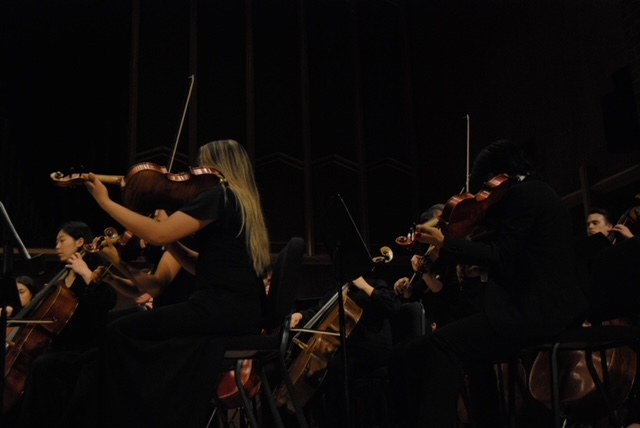The Symphony Orchestra’s interim director, Dr. Elliott Bark, took on the ambitious task of performing two impressive works at this semester’s Spring Concert: Mahler’s Fourth Symphony and Liszt’s Piano Concerto No. 1, both known for musical intricacy and virtuosic expressiveness. This is impressive when considering the role Dr. Bark took over this school year, following the multi-decade legacy of Marlin Owen, who retired from directing the orchestra after the 2021-2022 school year. Dr. Bark’s own impressive resume and luminous personality were on full display on Saturday, and his presence and impact on the ensemble was tangible through a sound that filled the hall.
Unique to this semester, Dr. Bark was part of an audition committee that judged the Conservatory’s Concerto Competition, in which Conservatory students auditioned for the opportunity to play with the orchestra in a concert setting, reminiscent of a professional-level recital. Part of the excitement of this year’s spring concert was the chance to hear the two Concerto Competition winners: junior piano performance major Brahms Mulyawan and senior vocal performance major Ashley Holguin.
LISZT’S PIANO CONCERTO NO. 1
Franz Liszt’s Piano Concerto No. 1, with Mulyawan on piano, was the featured performance of the concert’s first half. The piece was captivating, showcasing Mulyawan’s natural ability to lead in both dynamics and expressiveness. The orchestra was a tremendous complement to the soloist and allowed him to shine through in unique ways. This performance was an immense achievement for Mulyawan, for the orchestra, and for the Conservatory, as it allowed for one of its brightest young musicians to showcase his abilities through a powerful performance.
It was refreshing to see a student take such a prominent role in a performance, as a performance that required such a strong player would normally be an invited guest musician, rather than a Biola student. Allowing a student to take on that responsibility showed a tremendous amount of maturity from both the Conservatory and Mulyawan himself. He oozed confidence and musicality, which created newfound energy within the orchestra and audience.
MAHLER’S FOURTH SYMPHONY
The works of Gustav Mahler are some of the most popular musical works of the early 20th century, selling out concert halls year-round. Mahler’s Fourth Symphony is famous for a unique fourth movement that features a soprano soloist. For this performance, senior vocal performance major Ashley Holguin was selected. Holguin’s powerful, yet tender voice matched perfectly with a work like Mahler’s Fourth, which often ebbs and flows between the calm and boisterous.
Holguin’s performance was especially impressive in terms of the coordination required of both Dr. Bark, the conductor, and the orchestra in order to bring that extra push necessary for the fourth movement of the work. Holguin and the orchestra were able to accomplish this beautifully. The sweet, serene moments were moments where Holguin’s beautiful tone shone through, and harsh musical phrases complemented her mature sound. Once again, incorporating a student musician like Holguin was a special opportunity for the orchestra, and allowed them to feature the talented students of the Conservatory.
At the end of the night, Mahler’s Fourth rang through Crowell Hall like perhaps no other piece could do, with a brilliant sound and an energetic performance.












